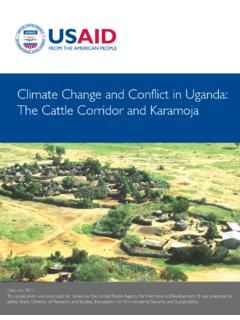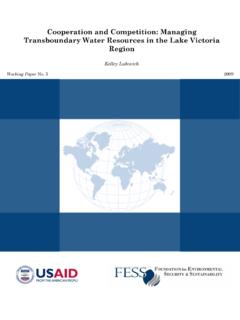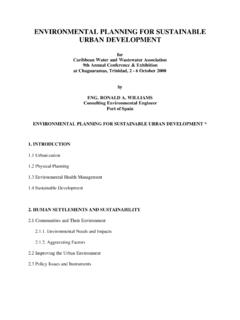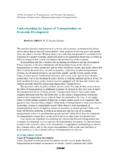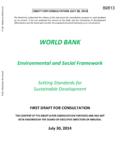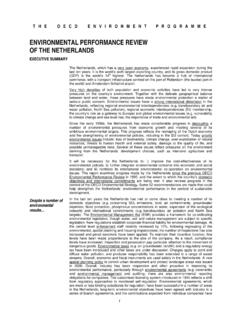Transcription of Environmental Impact Assessments in Developing …
1 Environmental Impact Assessments in Developing countries : An Opportunity for Greater Environmental Security? Jennifer C. Li 2008 Working Paper No. 4 1 Working Paper Introduction The Environmental Impact assessment (EIA) process, which originated in the United States in the late 1960s and early 1970s, has been adopted extensively in the rest of the world. The model and that of other developed countries share basic principles and reflects commonly agreed-upon approaches to similar problems. While EIAs in Developing countries are based on the same set of principles, their implementation often falls considerably short of international standards. They frequently suffer from insufficient consideration of impacts, alternatives, and public participation. In the worst case, they are not conducted at all.
2 This is particularly troubling given that Environmental Impact Assessments often are the chief and most comprehensive means for assessing the potential Environmental and social impacts of large-scale development projects in countries where Environmental safeguards are weak due to deficiencies in regulation, enforcement, or both. Moreover, these inadequacies may have serious implications in many areas of the Developing world, where an ambitious line-up of major projects is being developed. The first half of this Working Paper will give a background of the origins and development of Environmental Impact Assessments . The second half of the paper will focus on Environmental Impact Assessments in Southeast Asia, specifically the Mekong River Basin countries (China, Laos, Cambodia, Thailand, and Vietnam), a region where many new projects will be located in the near future, and which suffers from notable inadequacies in its EIA processes and practices.
3 The goal is to help identify gaps between EIA practices in the five countries listed above and internationally recognized best practices. Ample evidence suggests that in the Mekong region the Environmental and socioeconomic impacts of many projects have not been assessed adequately despite the use of EIAs. The paper presents the characteristics and flaws of EIAs in each country, and argues that if such deficiencies are allowed to continue, the region is likely to see more frequent and serious environmentally induced conflicts. Improving EIAs and increasing transnational collaboration in implementing them not only will help to prevent or mitigate conflict but also may enhance transnational Environmental management. The EIA Process The EIA process has several important purposes.
4 It is first and foremost a decision-making aid to prevent projects with strongly negative Environmental impacts from going forward. The emphasis in EIAs, in contrast with other mechanisms for Environmental protection such as a cost-effectiveness analysis, is on a systematic, holistic, and multidisciplinary assessment of the potential impacts of specific projects on the environment. EIAs also are meant to help inform development decisions by mandating a consideration of alternatives (including alternative project locations, scales, processes, layouts, operating conditions, or in some cases, the option of desisting from implementing a project) and ways to prevent, mitigate, and control potential negative Environmental and social impacts. The process generally involves a number of steps, including project screening, scoping, an EIA report (consideration of alternatives, 2 Working Paper identification of major impacts, and mitigation measures), public participation, review, decision, and monitoring.
5 See Appendix 1 for more details. In most countries , Developing countries included, there are laws to facilitate public involvement and expert consultation in the EIA process. In the best cases, input is sought during both the initial stage of reviewing core issues and the later stages involving consideration of alternatives, impacts, and initial EIA findings. Moreover, beyond evaluating specific projects, more comprehensive Environmental assessment increasingly is considered a necessary part of a nation s pursuit of sustainable development at all levels of decision making. The kinds of projects covered by EIAs have been widening. In general, an EIA has been applied to undertakings defined as major projects based on the level of investment, type of activity, scale of activity, land area covered, potential Environmental impacts, or a combination of these factors.
6 See Table 1. Table 1. Characteristics of Major Projects Require substantial capital investment. Cover large areas. Employ many people, either in project construction or operation. Involve a complex array of organizational links. Have wide-ranging impacts, in terms of size of area affected and type of Impact . Cause significant Environmental impacts. Require special procedures such as public inquiries and special bills approved through the legislative process. Involve certain types of activity, including manufacturing and extractive projects, such as petrochemical plants, steelworks, mines, and quarries; service projects, such as leisure developments, and out-of-town shopping centers; and utilities and infrastructure, such as power stations, roads, reservoirs, pipelines, and barrages. Anticipate high production levels. Source: Glasson et al.
7 2005; CEC 1982. The country with the longest experience with EIAs is the United States, where EIA legislation was passed in 1970. Elsewhere, EIA procedures are considered the strongest in Canada, Australia, New Zealand, and the Netherlands, where there is a robust track record of public participation, meaningful consideration of alternatives, and the consideration of cumulative impacts. Taking a broader view that includes the relationships of EIAs to a larger set of Impact Assessments and planning-related tools (Sadler 1999), Table 2 lays out a summary of international best and worst-case Environmental assessment (EA) performances. 3 Working Paper Table 2. Summary of International Best and Worst-Case EA Performances Best-case performance The EA process: Facilitates informed decision making by providing clear, well-structured, dispassionate analysis of the effects and consequences of proposed actions.
8 Assists the selection of alternatives, including the selection of the best practicable or most environmentally friendly option. Influences both project selection and policy design by screening out environmentally unsound proposals, as well as modifying feasible action. Facilitates meaningful public engagement and review in at least two stages of the process: once when scoping the impacts and issues to be considered, and again during the presentation of initial findings of the EIA, including a non-technical summary. Encompasses all relevant issues and factors, including cumulative effects, social impacts, and health risks. Directs (not dictates) formal approvals, including the establishment of terms and conditions of implementation and follow-up. Results in the satisfactory prediction of the adverse effects of proposed actions and their mitigation using conventional and customized techniques.
9 Serves as an adaptive, organizational learning process in which the lessons experienced are fed back into policy, institutions, and project designs. Worst-case performance The EA process: Is inconsistently applied to development proposals with many sectors and classes of activity omitted. Operates as a stand alone process, poorly related to the project cycle and approval process and consequently is of marginal influence. Has a non-existent or weak follow-up process, lacking surveillance and enforcement of terms and conditions, effects monitoring, etc. Does not consider cumulative effects or social, health, and risk factors. Makes little or no reference to the public or public consultation is perfunctory, substandard, and takes no account of the specific requirements of affected groups. Results in EA reports that are voluminous, poorly organized, descriptive, and overly technical.
10 Provides information that is unhelpful or irrelevant to decision making. Is inefficient, time consuming, and costly in relation to the benefits delivered. Understates and insufficiently mitigates Environmental impacts and loses credibility. Source: Sadler 1996; Glasson et al. 2005. One of the most important challenges for EIAs is the assessment of cumulative impacts. Cumulative impacts and changes to the environment are those that are caused by an action in combination with other past, present, and future human actions (Odum 1982). Cumulative impacts are important because many projects might pose minor risks to the environment in and of themselves but pose a significant risk to the environment in combination with other 4 Working Paper activities (Odum 1982). New Zealand and Canada both mandate a cumulative Impact assessment as part of the EIA.

